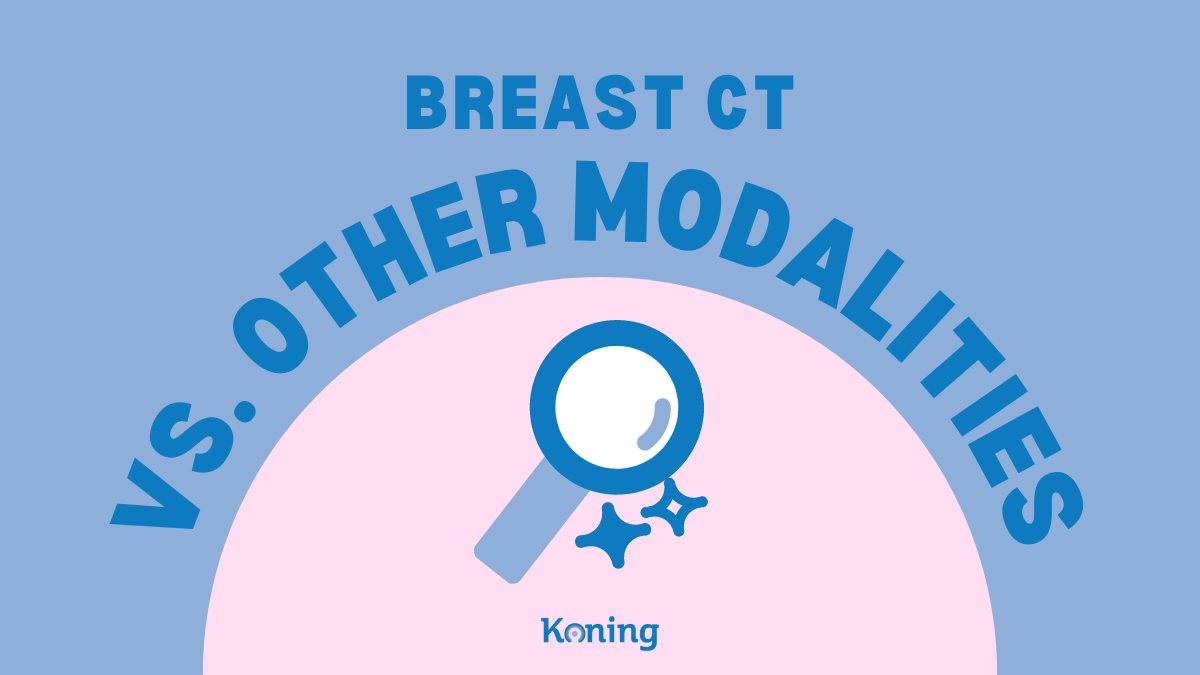
- Blog /
- March 23, 2022
Koning Breast CT Compared to Other Imaging Options
Early imaging and detection is the key to breast cancer survival. Thankfully, modern technology has advanced to the point where there are many diagnostic options available. However, these options vary greatly in terms of convenience, cost, and effectiveness. Today, we will discuss these various imaging methods with a particular focus on Koning’s innovative approach to cancer prevention.
Currently, there are several main modalities for breast cancer detection: mammography, digital breast tomosynthesis (DBT), ultrasound, magnetic resonance imaging (MRI), and — of course — Koning Breast CT. The criteria for evaluating them involve factors of diagnostic efficiency, patient experience, expense, and safety. Let’s dive in!
Traditional Mammography
Although a mammogram is the most long-standing method for detecting breast cancer, it certainly has its downsides. This procedure involves compressing the breast in order to take two or more x-ray pictures of the tissue in order to detect tumors and microcalcifications. Mammograms are done any time a lump or abnormality is found during a clinical or self exam. They are also recommended as routine, yearly procedures for all women over forty.
Unfortunately, mammograms are not as effective as one would hope because they yield two-dimensional imagery, making it easier for tumors to hide in the dense breast tissue. As a result, about 20% of breast cancers are not detected during this type of imaging. In addition, the procedure itself is uncomfortable and can even be painful as the breast must be squeezed quite roughly in order to secure a valid image. Let’s just say that most women do not look forward to their annual mammogram.
Digital Breast Tomosynthesis (DBT)
DBT is essentially a mammogram that is capable of creating three-dimensional imagery, making it a lot more effective at detecting tumors and cancer than traditional 2-D mammography. The issue with two-dimensional imaging is that breast tissue appears identical to cancer tissue, so taking a flat snapshot of the area allows many abnormalities to blend in with healthy tissue. The DBT procedure allows for a deeper, more accurate exploration of the breast, reducing the risk of missing cancers and tumors.
Having said that, the DBT procedure is still very similar to mammograms in that it relies on two dimensional pictures to compile a three dimensional result. It is also exactly alike in terms of patient experience, failing to eliminate the painful discomfort of traditional mammograms.
Ultrasound
Using ultrasound technology is not a common approach in breast cancer imaging. It is used primarily as an alternative to mammograms for patients whose breast tissue is particularly dense. Ultrasounds can be useful in differentiating between solid and fluid-filled masses, and they can help guide a biopsy. It is performed by moving a wand-like instrument around on the breast, so it is not as uncomfortable as a mammogram or a DBT.
However, ultrasound imaging is limited in that it produces only 2-D imaging, and it does not guarantee the detection of cancer. It is simply another way to look inside the breast if an abnormality occurs. In other words, ultrasounds are great if you already know that you’re looking for something potentially cancerous; they do not help with comprehensive preventative detection.
MRI
Magnetic resonance imaging uses magnets instead of radiation to create cross-sectional pictures of the breast. While this procedure is not as uncomfortable as a mammogram, it requires the injection of a special contrast dye into the vein. While this method of imaging is certainly more accurate than those discussed above, it relies on rare and costly equipment that may not be available at your local hospital. As a result, this approach to breast cancer detection turns out to be more expensive and less accessible than some of the other options.
Koning Vera Breast CT (KBCT)
The FDA approved procedure by Koning is one of the latest innovations in breast cancer imaging technology. It eliminates all of the problems in other modalities and is essentially the gold standard for modern diagnostic care. The KBCT yields high quality, 3-D imagery that is not merely compiled from 2-D snapshots, but created in real time. It is the most accurate representation of the examined breast of all the modalities, revealing the intricate details of the tissue structure and guaranteeing high success rates of detection.
In terms of the patient experience, the KBCT is absolutely painless and even peaceful. The patient is asked to lie down for a mere 10 seconds, during which no uncomfortable physical contact is made with the breast. In addition, KBCT is affordable and accessible; it is truly a revolutionary approach to breast cancer screening and detection. For more information, go to koninghealth.com!
